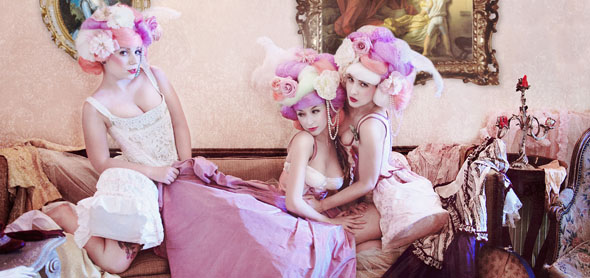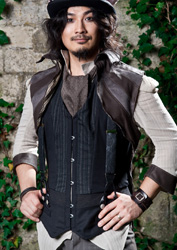You are getting married and looking for a one of kind, original tailor-made dress?
Corsets, historical costumes and dresses fascinate you, but also scare you off a little?
Ladies and gentlemen, here you will find all the answers to your questions!
Summary :
-
The corset and its advantages
-
The historical dress, under wear and outer wear
-
The corset dress
-
Original and atypical creations
1- The corset and its advantages
From its first appearance during Renaissance, the corset always held a very important place in the fashion history, changing its shape, cut or materials through the centuries, modeling bodies and silhouettes. After being abandoned during the 1920/1930’s, the corset is now making its big come back in modern fashion, not as a constraint anymore, but as a beautiful, special garment you wear whenever you feel like, to show yourself to advantage.
Nowadays, the corset still carries clichés around (“A corset? It might be so uncomfortable and oppressive!”), but those who have tasted the joys of tailor-made corsets would be the first to deny it.
Indeed, a good tailor-made corset slims the body just where it is supposed to be – at the waist – mould the hips and the ribbing without crushing it, and its back lacing allows you to adjust the tightening during the day, at the whim of your wishes and the counted effect.
A made-to-measure corset guaranties an idealized silhouette as no other clothe could : a flat stomach, a slimed waist and an enhanced breast!
As for you gentlemen – yes, men also have the right to get their own corset – it will bring you a presence, a king bearing, and also will get rid of your little belly!
It is especially suited for weddings, as an original and elegant piece for a dandy look!
2 – The historical dress, under wear and outerwear
Except the corset, some other artifices and structures were used through the centuries, to model the body and the silhouette at the whim of fashions.
Let me present to you the different silhouettes and fashion eras, all very different from one to another, and of which I have make my speciality.
• The 18th century
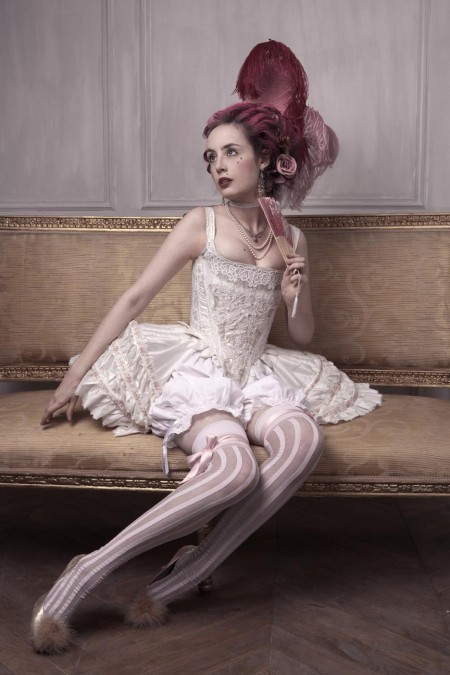 During the 18th century, the bust is retained by stays, a shoulder strapped, conical shaped, flat fronted corset stopping at the waist.
During the 18th century, the bust is retained by stays, a shoulder strapped, conical shaped, flat fronted corset stopping at the waist.
The steel bones used a century or so later didn’t exist at that time, so the corset was inserted with real whale bones. That is why this name is still used nowadays, even it the use of actual whale bones were quickly dropped.
At that time, the corset was the equivalent of the brassiere for a push-up effect, and was used to slim the waist and support the outer dress.
Another important element of the 18th century silhouette : the panniers.
There are several existing shapes, but the most well-known one is a pocket-like flip-up boned, top opened panniers.
Worn at the waist under the dress, they give it this very special shape, flared on the sides.
Those panniers can be still very handy nowadays, especially for brides, to fit in some items such as a fan, some tissue papers or even a cell-phone, without people noticing it!
On the top of those underwear were worn a petticoat and a skirt, and also a short or long dress coat.
You are getting married and wish to put your hands on a rococo dress , just like Marie-Antoinette’s one?
Please have a look at my 18th century order-made and original creations, to discover a big range of dresses, corset and panniers.
Either you wish to base your dress on an existing one, or create your own original dress, don’t hesitate to contact me for a quote, and I will do my best to make your dream dress come true!
• 19th and early 20th centuries
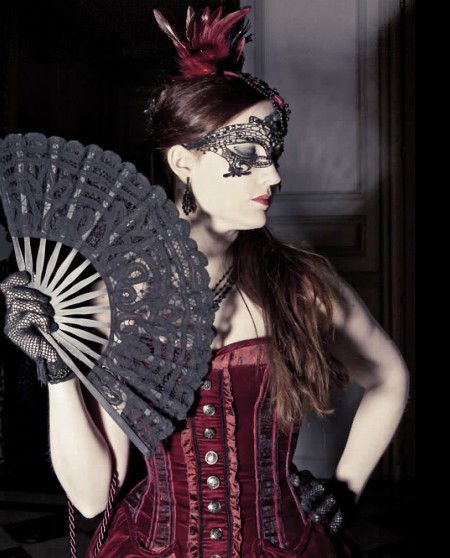 After a short break during the Regency era, when high waisted, long flowing light cottoned dress were honored, the corset comes back with a very different shape, which will evolve through the century.
After a short break during the Regency era, when high waisted, long flowing light cottoned dress were honored, the corset comes back with a very different shape, which will evolve through the century.
The victorian corset and its hourglass shape, still mostly used nowadays, will be followed by the edwardian corset and its famous S-curved silhouette.
Unlike the 18th century stays, the 19th century corset makes curvier breast and hips, giving it a more natural profile shape, and goes down on the hips, emphasizing even more the slimness of the waist.
As for the structures, the very popular crinoline will be left behind for some time, before the bustle takes over, for a back thrust volume, often emphasized by the use of trains.
Again, the under wear – corset and bustle – will be dressed up with a dress or matching skirt and bodice or jacket.
You are tempted by a the19th century era? Don’t hesitate to have a look at this 19th century order-made gallery section.
Finally, if the corset was used as a hidden underwear in the past, and was meant to be covered by a dress, nowadays the corset could be both an underwear, or the main outer piece of an outfit, worn with a matching skirt.
For a wedding dress, you could therefore consider wearing a full 18th or 19th century dress, and then take off the dress coat during the evening to show the corset, and therefore reveal a different facet of your outfit, which will also be lighter to spend the night walking and dancing around.
3 – The Corset dress
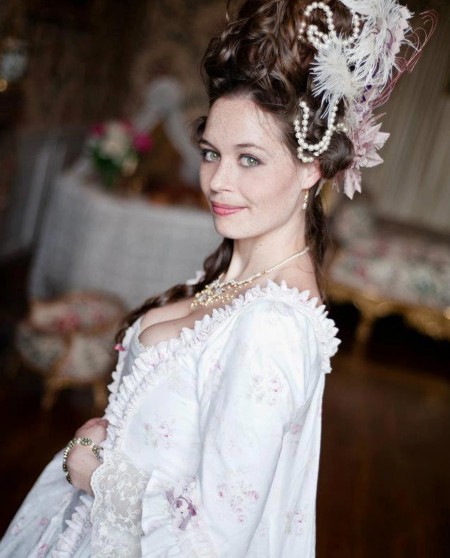 For those of you who appreciate the shapes and elegance of a historical dress but could be scared by the successive layers, the corset dress is the perfect compromise : a single dress with a corseted bust, using the same techniques and materials (coutil, bones, adjustable back lacing), and offering the same body emphasizing characteristics (waist reduction, pushed-up breast).
For those of you who appreciate the shapes and elegance of a historical dress but could be scared by the successive layers, the corset dress is the perfect compromise : a single dress with a corseted bust, using the same techniques and materials (coutil, bones, adjustable back lacing), and offering the same body emphasizing characteristics (waist reduction, pushed-up breast).
It is also more economical, as it is an all-in-one dress.
Just wear it with some panniers for an 18th century style, on a bustle for a 19th century look, or on a petticoat for a more modern corset dress.
In some cases, it is even possible to make an integrated bustle dress.
Discover through the following link all my Corset Dresses.
4 – Original and Atypical Creations
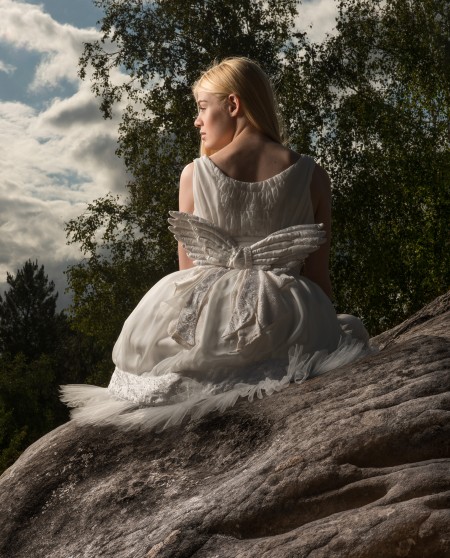 If you appreciate Clara Maeda’s creative world, but are interested by an order-made dress inspired by some other fashioning eras, more modern, or straight out of your imagination, don’t hesitate to contact me : my work and my biggest pleasure is to follow your wishes and expectations, to find together the best matching, enhancing outfit.
If you appreciate Clara Maeda’s creative world, but are interested by an order-made dress inspired by some other fashioning eras, more modern, or straight out of your imagination, don’t hesitate to contact me : my work and my biggest pleasure is to follow your wishes and expectations, to find together the best matching, enhancing outfit.
Together we will define your project, either it is a modified model based on one of my collections or creations, or a unique one, I will be there to guide you, advice you and make your dream dress come true!
As the corset is my speciality, most of my creations are corset dresses or matching corsets and skirts, but I also make dresses or costumes without it, such as regency dresses.
Structures like panniers or bustle could also be used for a more modern project, to model the silhouette as crinoline does it for a lot of modern wedding dresses nowadays.
To get an insight, please head towards the original and atypical creations section.
Finally, to be in perfect harmony on your big day, don’t hesitate to send your loved one to me : I create redingotes, jackets, men’s corsets, shirts and trousers on demand!
[one_half]
Budget :
– for a full tailor-made historical wedding dress, including corset, panniers, skirt and dress coat/bodice/jacket, count on about 1800 to 2500€.
This budget includes the definition and the sketch of your project, the fitting(s), the fabrics, and the production time.
The budget will vary depending on the complexity of the model, the level of decorations and finishing touches, and of course the fabrics.
– For a wedding corseted dress, allow a budget of about 800 to 1500€.
Likewise, this budget includes the definition and the sketch of your project, the fitting(s), the fabrics, and the production time.
The fabrics I use for wedding dresses are fine and high-quality :
I mostly work with silk of all forms and weavings (dupinoni, taffeta, satin, velvet, chiffon…) as this fabric offers a very natural brilliance perfect for big occasions.
I also use a lot of beading, laces, and all kind of subtle decorations adding elegant texture to the dress.
[/one_half]
[one_half_last]
Definition and production time :
The perfect needed timing for your project is 6 to 10 months.It will allow us to take time to define together the dress and possible accessories, order the fabrics, do the fitting(s) and make the dress without stress.
However, if you have a shorter deadline, don’t hesitate to contact me, I always try my best for brides in distress!
Together we will see what is feasible in the best conditions with your pressing due date!
[/one_half_last]

